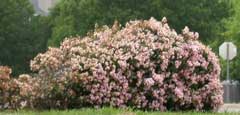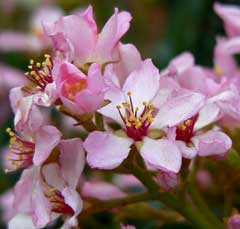 |
|
davesgarden.com |
 |
| http://commons.wikimedia.org/wiki/User:Stan_Shebs |
Translate this page:
Summary
Bloom Color: Pink, White. Main Bloom Time: Early fall, Early spring, Late fall, Late spring, Mid fall, Mid spring. Form: Rounded, Spreading or horizontal.
Physical Characteristics

 Rhaphiolepis indica is an evergreen Shrub growing to 1.5 m (5ft) by 2 m (6ft) at a slow rate.
Rhaphiolepis indica is an evergreen Shrub growing to 1.5 m (5ft) by 2 m (6ft) at a slow rate.
See above for USDA hardiness. It is hardy to UK zone 8. It is in leaf all year, in flower from May to June, and the seeds ripen from August to September. The species is hermaphrodite (has both male and female organs) and is pollinated by Insects.
Suitable for: light (sandy), medium (loamy) and heavy (clay) soils and prefers well-drained soil. Suitable pH: mildly acid, neutral and basic (mildly alkaline) soils. It cannot grow in the shade. It prefers dry or moist soil and can tolerate drought.
UK Hardiness Map
US Hardiness Map
Synonyms
Crataegus indica.
Plant Habitats
Woodland Garden Sunny Edge; Hedge;
Edible Uses
Edible Parts: Fruit
Edible Uses:
Fruit. [1, 2, 105]. The fruit is about 8mm in diameter[266]. No more details are given.
References More on Edible Uses
Medicinal Uses
Plants For A Future can not take any responsibility for any adverse effects from the use of plants. Always seek advice from a professional before using a plant medicinally.
None known
References More on Medicinal Uses
The Bookshop: Edible Plant Books
Our Latest books on Perennial Plants For Food Forests and Permaculture Gardens in paperback or digital formats.

Edible Tropical Plants
Food Forest Plants for Hotter Conditions: 250+ Plants For Tropical Food Forests & Permaculture Gardens.
More

Edible Temperate Plants
Plants for Your Food Forest: 500 Plants for Temperate Food Forests & Permaculture Gardens.
More

More Books
PFAF have eight books available in paperback and digital formats. Browse the shop for more information.
Shop Now
Other Uses
Dye Hedge Hedge
Plants can be used for informal hedging in areas that are frost free or almost so[200]. Dark blue, turquoise and purple dyes are obtained from the fruit[168].
Special Uses
Hedge Hedge
References More on Other Uses
Cultivation details
Landscape Uses:Border, Erosion control, Foundation, Ground cover, Massing, Standard, Seashore. Requires a well-drained moisture retentive fertile loam or peaty soil in a warm sheltered sunny position[200]. Tolerates all but the hottest desert climates[184]. A very ornamental plant[1], it is hardier in Britain than is generally supposed, tolerating temperatures down to about -10°c[184]. Plants succeed outdoors in S. Cornwall[11, 49, 59] but are generally best grown on a sunny south-facing wall[11]. Plants do not require pruning[182]. A polymorphic species, there are a number of named varieties selected for their ornamental value[200]. Plants resent root disturbance and so are best grown in pots and then planted out into their permanent positions as soon as possible[200]. Special Features:Not North American native, Fragrant flowers, Attractive flowers or blooms.
References Carbon Farming Information and Carbon Sequestration Information
Temperature Converter
Type a value in the Celsius field to convert the value to Fahrenheit:
Fahrenheit:
The PFAF Bookshop
Plants For A Future have a number of books available in paperback and digital form. Book titles include Edible Plants, Edible Perennials, Edible Trees,Edible Shrubs, Woodland Gardening, and Temperate Food Forest Plants. Our new book is Food Forest Plants For Hotter Conditions (Tropical and Sub-Tropical).
Shop Now
Plant Propagation
Seed - best sown as soon as it is ripe in a shady position in a warm greenhouse[78]. Stored seed should be sown in February/March in a warm greenhouse[78]. Germination is variable[78]. When they are large enough to handle, prick the seedlings out into individual pots and grow them on in the greenhouse for at least their first winter. Plant them out into their permanent positions in late spring or early summer, after the last expected frosts. Cuttings of half-ripe wood, 5cm with a heel, September/October in a frame. Fair percentage[78, 113]. Layering[200].
Other Names
If available other names are mentioned here
Native Range
TEMPERATE ASIA: China (Anhui Sheng, Fujian Sheng, Gansu Sheng, Guangdong Sheng, Guangxi Zhuangzu Zizhiqu, Guizhou Sheng, Hebei Sheng, Henan Sheng, Hubei Sheng, Hunan Sheng, Jiangsu Sheng, Jiangxi Sheng, Shaanxi Sheng, Shanxi Sheng, Sichuan Sheng, Zhejiang Sheng) China (Anhui Sheng, Fujian Sheng, Guangdong Sheng, Guangxi Zhuangzu Zizhiqu, Guizhou Sheng, Hunan Sheng, Jiangxi Sheng, Yunnan Sheng, Zhejiang Sheng), Taiwan TROPICAL ASIA: Cambodia, Laos, Thailand, Vietnam
Weed Potential
Right plant wrong place. We are currently updating this section.
Please note that a plant may be invasive in one area but may not in your area so it's worth checking.
Conservation Status
IUCN Red List of Threatened Plants Status :

Growth: S = slow M = medium F = fast. Soil: L = light (sandy) M = medium H = heavy (clay). pH: A = acid N = neutral B = basic (alkaline). Shade: F = full shade S = semi-shade N = no shade. Moisture: D = dry M = Moist We = wet Wa = water.
Now available:
Food Forest Plants for Mediterranean Conditions
350+ Perennial Plants For Mediterranean and Drier Food Forests and Permaculture Gardens.
[Paperback and eBook]
This is the third in Plants For A Future's series of plant guides for food forests tailored to
specific climate zones. Following volumes on temperate and tropical ecosystems, this book focuses
on species suited to Mediterranean conditions—regions with hot, dry summers and cool, wet winters,
often facing the added challenge of climate change.
Read More
Expert comment
Author
(L.)Lindl.
Botanical References
11200266
Links / References
For a list of references used on this page please go here
Readers comment
© 2010, Plants For A Future. Plants For A Future is a charitable company limited by guarantee, registered in England and Wales. Charity No. 1057719, Company No. 3204567.